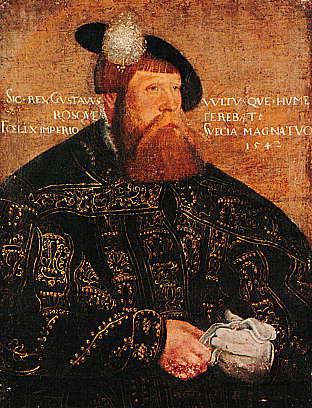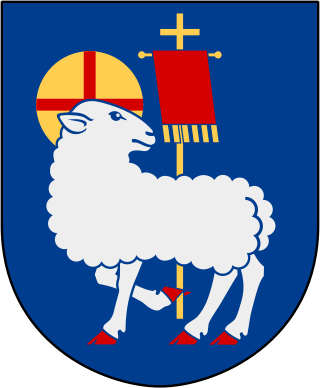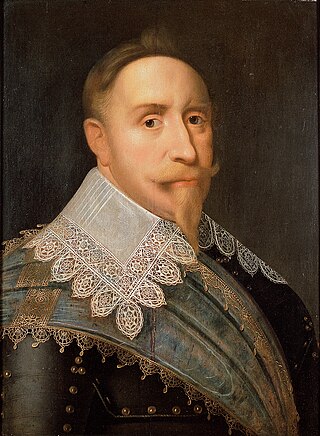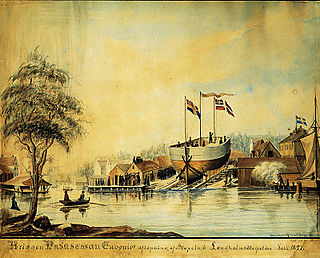Births
| | This section needs expansion. You can help by adding to it. (June 2015) |
- Hedvig Sophia of Sweden, princess (died 1708)
| Years in Sweden: | 1678 1679 1680 1681 1682 1683 1684 |
| Centuries: | 16th century · 17th century · 18th century |
| Decades: | 1650s 1660s 1670s 1680s 1690s 1700s 1710s |
| Years: | 1678 1679 1680 1681 1682 1683 1684 |
Events from the year 1681 in Sweden
| | This section needs expansion. You can help by adding to it. (June 2015) |
| | This section needs expansion. You can help by adding to it. (June 2015) |

The Kalmar Union was a personal union in Scandinavia, agreed at Kalmar in Sweden, that from 1397 to 1523 joined under a single monarch the three kingdoms of Denmark, Sweden, and Norway, together with Norway's overseas colonies.

Mälaren, historically referred to as Lake Malar in English, is the third-largest freshwater lake in Sweden. Its area is 1,140 km2 and its greatest depth is 64 m. Mälaren spans 120 kilometers from east to west. The lake drains, from south-west to north-east, into the Baltic Sea through its natural outlets Norrström and Söderström and through the artificial Södertälje Canal and Hammarbyleden waterway. The easternmost bay of Mälaren, in central Stockholm, is called Riddarfjärden. The lake is located in Svealand and bounded by the provinces of Uppland, Södermanland and Västmanland. The two largest islands in Mälaren are Selaön (91 km2) and Svartsjölandet (79 km2). Mälaren is low-lying and mostly relatively shallow.

The Great Northern War (1700–1721) was a conflict in which a coalition led by the Tsardom of Russia successfully contested the supremacy of the Swedish Empire in Northern, Central and Eastern Europe. The initial leaders of the anti-Swedish alliance were Peter I of Russia, Frederick IV of Denmark–Norway and Augustus II the Strong of Saxony–Poland–Lithuania. Frederick IV and Augustus II were defeated by Sweden, under Charles XII, and forced out of the alliance in 1700 and 1706 respectively, but rejoined it in 1709 after the defeat of Charles XII at the Battle of Poltava. George I of Great Britain and the Electorate of Hanover joined the coalition in 1714 for Hanover and in 1717 for Britain, and Frederick William I of Brandenburg-Prussia joined it in 1715.

Gustav I, born Gustav Eriksson of the Vasa noble family and later known as Gustav Vasa, was King of Sweden from 1523 until his death in 1560, previously self-recognised Protector of the Realm (Riksföreståndare) from 1521, during the ongoing Swedish War of Liberation against King Christian II of Denmark, Norway and Sweden. Gustav rose to lead the Swedish War of Liberation following the Stockholm Bloodbath, where his father was executed. Gustav's election as king on 6 June 1523 and his triumphant entry into Stockholm eleven days later marked Sweden's final secession from the Kalmar Union.

Adolf Frederick, or Adolph Frederick was King of Sweden from 1751 until his death in 1771. He was the son of Christian August of Holstein-Gottorp, Prince of Eutin, and Albertina Frederica of Baden-Durlach. He was an uncle of Catherine the Great and husband to Louisa Ulrika of Prussia.

Stockholm County is a county on the Baltic Sea coast of Sweden. It borders Uppsala County and Södermanland County. It also borders Mälaren and the Baltic Sea. The city of Stockholm is the capital of Sweden. Stockholm County is divided by the historic provinces of Uppland (Roslagen) and Södermanland (Södertörn). More than one fifth of the Swedish population lives in the county. Stockholm County is also one of the statistical riksområden according to NUTS:SE, Nomenclature of Territorial Units for Statistics within the EU. With more than two million inhabitants, Stockholm is the most densely populated county of Sweden.

The Royal Swedish Academy of Fine Arts, commonly called the Royal Academy, is located in Stockholm, Sweden. An independent organization that promotes the development of painting, sculpture, architecture, and other fine arts, it is one of several Swedish Royal Academies. The Royal Institute of Art, an art school that was once an integral part of the academy, was broken out in 1978 as an independent entity directly under the supervision of the Ministry of Education.

Stockholm Palace or the Royal Palace is the official residence and major royal palace of the Swedish monarch. Stockholm Palace is on Stadsholmen, in Gamla stan in the capital, Stockholm. It neighbours the Riksdag building. The offices of the King, the other members of the Swedish royal family, and the Royal Court of Sweden are here. The palace is used for representative purposes by the King whilst performing his duties as the head of state.

The Drottningholm Palace is the private residence of the Swedish royal family. Drottningholm is near the capital Stockholm. Built on the island Lovön, it is one of Sweden's Royal Palaces. It was originally built in the late 17th century, and it served as a regular summer residence of the Swedish royal court for most of the 18th century. Apart from being the private residence of the Swedish royal family, the palace is a popular tourist attraction.
The Treaties of Stockholm are two treaties signed in 1719 and 1720 that ended the war between Sweden and an alliance of Hanover and Prussia.

The Great Synagogue of Stockholm is located on a small street called Wahrendorffsgatan, close to the park Kungsträdgården on Norrmalm, Stockholm. It was built 1867-1870 according to designs made in 1862 by the architect Fredrik Wilhelm Scholander. The building has been called a "paraphrase over Oriental motifs", and it is listed in the Swedish registry of national historical buildings. It was preceded by an earlier synagogue at Tyska Brunnsplan in the Stockholm Old Town, used 1790–1870, and services were held in an even earlier location on Köpmanbrinken near Köpmantorget in the Old town 1787–1790.

The Diocese of Västerås is a diocese within the Church of Sweden. Its Episcopal see is located in Västerås at Västerås Cathedral. The diocese was first established in the 12th century as part of the Roman Catholic church, but was made part of the Church of Sweden as a result of the Protestant Reformation in Sweden.

Sweden–Ukraine relations are foreign relations between Sweden and Ukraine. Diplomatic relations between the two countries were established on 13 January 1992. Sweden has an embassy in Kyiv and an honorary consulate in Kakhovka. Ukraine has an embassy in Stockholm. Both countries are members of the OSCE, Council of Europe, World Trade Organization and United Nations.

Gustav III, also called Gustavus III, was King of Sweden from 1771 until his assassination in 1792. He was the eldest son of King Adolf Frederick and Queen Louisa Ulrika of Sweden.

Gustavus Adolphus, also known in English as Gustav II Adolf or Gustav II Adolph, was King of Sweden from 1611 to 1632, and is credited with the rise of Sweden as a great European power. During his reign, Sweden became one of the primary military forces in Europe during the Thirty Years' War, helping to determine the political and religious balance of power in Europe. He was formally and posthumously given the name Gustavus Adolphus the Great by the Riksdag of the Estates in 1634.

Events from the year 1856 in Sweden

Events from the year 1847 in Sweden

Events from the year 1723 in Sweden.
Sweden witnessed several historic and significant events and developments during 1691 that left lasting marks upon both their history and wider European context. Notable political, cultural and societal developments give insight into what life was like during this era for Sweden's Kingdom.
Events from the year 1682 in Sweden